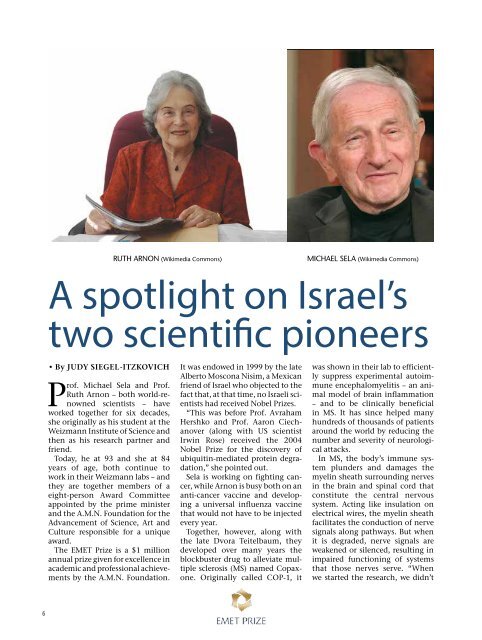Create successful ePaper yourself
Turn your PDF publications into a flip-book with our unique Google optimized e-Paper software.
RUTH ARNON (Wikimedia Commons)<br />
MICHAEL SELA (Wikimedia Commons)<br />
A spotlight on Israel’s<br />
two scientific pioneers<br />
• By JUDY SIEGEL-ITZKOVICH<br />
Prof. Michael Sela and Prof.<br />
Ruth Arnon – both world-renowned<br />
scientists – have<br />
worked together for six decades,<br />
she originally as his student at the<br />
Weizmann Institute of Science and<br />
then as his research partner and<br />
friend.<br />
Today, he at 93 and she at 84<br />
years of age, both continue to<br />
work in their Weizmann labs – and<br />
they are together members of a<br />
eight-person Award Committee<br />
appointed by the prime minister<br />
and the A.M.N. Foundation for the<br />
Advancement of Science, Art and<br />
Culture responsible for a unique<br />
award.<br />
The <strong>EMET</strong> Prize is a $1 million<br />
annual prize given for excellence in<br />
academic and professional achievements<br />
by the A.M.N. Foundation.<br />
It was endowed in 1999 by the late<br />
Alberto Moscona Nisim, a Mexican<br />
friend of Israel who objected to the<br />
fact that, at that time, no Israeli scientists<br />
had received Nobel Prizes.<br />
“This was before Prof. Avraham<br />
Hershko and Prof. Aaron Ciechanover<br />
(along with US scientist<br />
Irwin Rose) received the 2004<br />
Nobel Prize for the discovery of<br />
ubiquitin-mediated protein degradation,”<br />
she pointed out.<br />
Sela is working on fighting cancer,<br />
while Arnon is busy both on an<br />
anti-cancer vaccine and developing<br />
a universal influenza vaccine<br />
that would not have to be injected<br />
every year.<br />
Together, however, along with<br />
the late Dvora Teitelbaum, they<br />
developed over many years the<br />
blockbuster drug to alleviate multiple<br />
sclerosis (MS) named Copaxone.<br />
Originally called COP-1, it<br />
was shown in their lab to efficiently<br />
suppress experimental autoimmune<br />
encephalomyelitis – an animal<br />
model of brain inflammation<br />
– and to be clinically beneficial<br />
in MS. It has since helped many<br />
hundreds of thousands of patients<br />
around the world by reducing the<br />
number and severity of neurological<br />
attacks.<br />
In MS, the body’s immune system<br />
plunders and damages the<br />
myelin sheath surrounding nerves<br />
in the brain and spinal cord that<br />
constitute the central nervous<br />
system. Acting like insulation on<br />
electrical wires, the myelin sheath<br />
facilitates the conduction of nerve<br />
signals along pathways. But when<br />
it is degraded, nerve signals are<br />
weakened or silenced, resulting in<br />
impaired functioning of systems<br />
that those nerves serve. “When<br />
we started the research, we didn’t<br />
6

















